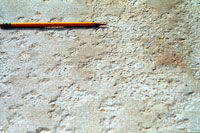
Example of scaled concrete surface.
Scaling is defined as a general loss of surface mortar or mortar surrounding the coarse aggregate particles on a concrete surface. This problem is typically caused by the expansion of water due to freezing and thawing cycles and the use of deicing chemicals; however, properly specified, produced, finished, and cured quality concrete need not suffer this type of deterioration. There is a distinct chain of responsibility for the production of scale resistant concrete.
Specifying (Architect/Engineer)
First, the concrete must be properly specified for its intended service environment. For severe climates where it is to be expected that concrete in a wet condition will undergo cycles of freezing and thawing and the application of deicing chemicals:
- Concrete should be specified with a minimum compressive strength of 4,000 psi.
- Contain an appropriate volume of air (entrapped and entrained).
- Have a minimum cementitious content of 564 pounds per cubic yard.
- Maximum water-cement ratio of 0.45.
These minimum specification requirements have produced positive results for many decades.
Proportioning and Delivery (Ready Mixed Concrete Producer)
Secondly, the concrete as proportioned and delivered by the ready mixed concrete producer must comply with the aforementioned specification requirements. It is the responsibility of the concrete producer to properly proportion the concrete mixture to comply with the specification and produce a workable mixture using locally available materials. The proposed mixture must have sufficient workability that the concrete contractor can place, consolidate, and finish in a timely fashion. One challenging issue for the concrete producer is choosing the correct air content for the mixture. The appropriate air content is dependent on the maximum coarse aggregate size but generally is in the range of 5 to 8 percent.
Finishing and Curing (Concrete Contractor)
After concrete has been placed, consolidated, and struck-off, the concrete finisher is charged with using proper finishing practices to achieve an aesthetically pleasing yet durable concrete surface.
The typical recommendations for finishing are as follows:
- Bullfloat, darby, edge, and make initial grooves prior to the onset of bleeding.
- Allow excess bleed water to evaporate from the concrete surface before floating the surface and making the second pass with edging and grooving tools.
- Allow time for initial stiffening of the concrete to take place.
- Make a final pass with edging, grooving, and floating operations. Avoid steel troweling exterior concrete surfaces, especially at later ages of stiffening. This can reduce entrained air and may promote scaling.
- Allow additional stiffening
- Use appropriate broom to produce the desired texture, soft bristle for fine and medium textures, stiff bristle for coarse texture.
After the final texture is established concrete, must be cured to assure that the surface will achieve the desired properties to be durable.
Curing methods may include:
- Moist curing with water, fogging, or sprinkling of absorptive coverings.
- Spray applied curing compounds
- Plastic sheet cover Caution: This may cause discoloration on exposed concrete surfaces.
And finally, exterior concrete should be allowed to air dry for 30 days prior to exposure to freezing and thawing cycles. In addition, deicer chemicals should not be used on the new concrete surface for a period of three months after the concrete has been placed—longer if the concrete is placed during the fall or winter seasons.
References
Kosmatka, S.H., Wilson, M.L.,
Design and Control of Concrete Mixtures,15th Edition, EB001.15, Portland Cement Association, 2011.
Collins, Terry C., Panarese, William C., Bradley, Bentley J.,
Concrete Finisher’s Guide, EB122, 2006, 88 pages.
Concrete Slab Surface Defects: Causes, Prevention, Repair, 2001, 16 pages.